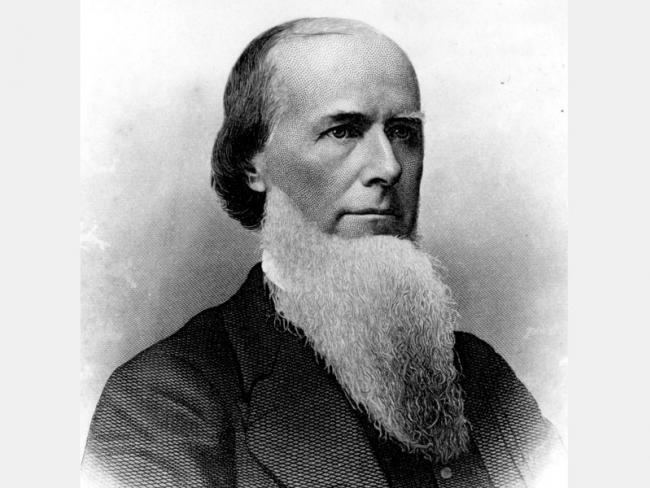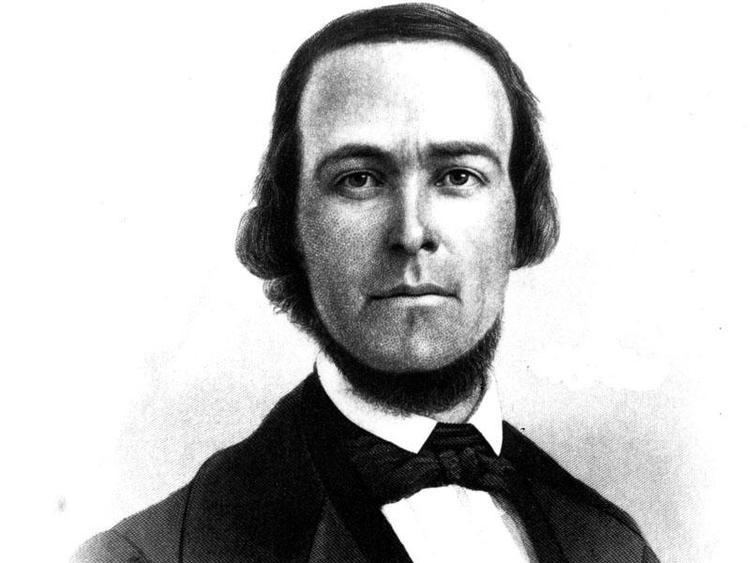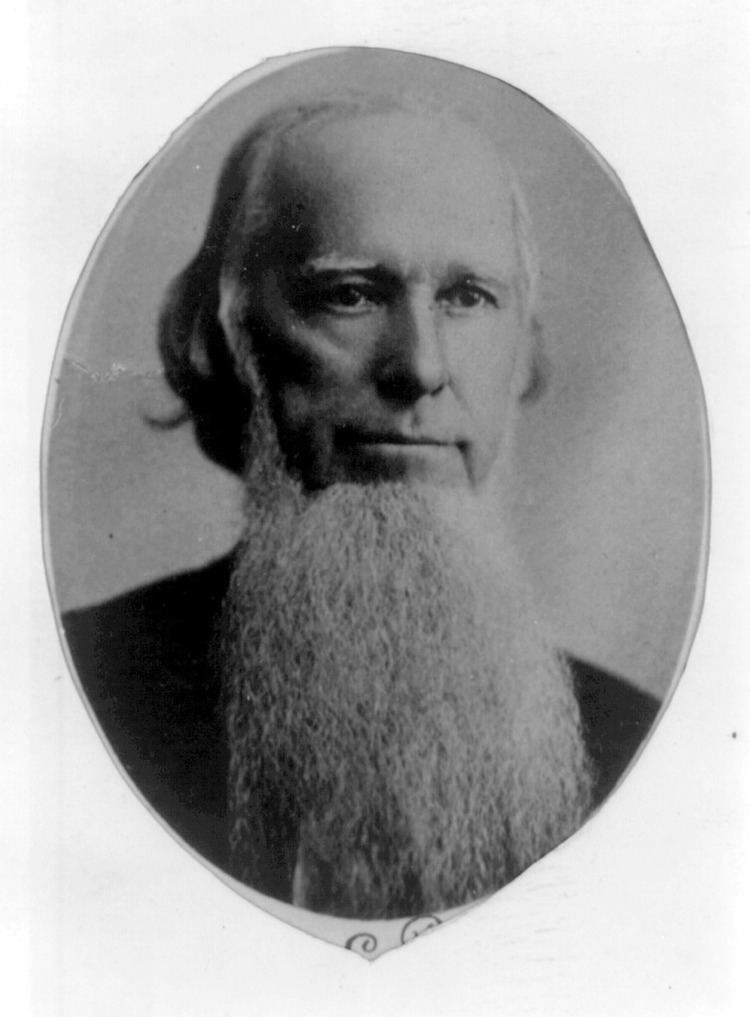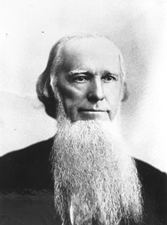Preceded by John B. Gordon Education Yale Law School Role U.S. senator | Name Joseph Brown Preceded by Herschel Johnson Succeeded by John Brown Gordon | |
 | ||
Political party | ||
Joseph Emerson Brown (April 15, 1821 – November 30, 1894), often referred to as Joe Brown, was an attorney and politician, serving as the 42nd Governor of Georgia from 1857 to 1865, the only governor to serve four terms. After the American Civil War, he was elected by the state legislature as a two-term U.S. Senator, serving from 1880 to 1891. Brown was a leading secessionist in 1861, and led his state into the Confederacy.
Contents
- Early life and education
- Career
- The capture of Milledgeville
- Post war imprisonment to Republican judgeship
- Making a million
- Death and legacy
- In fiction
- References

A former Whig, and a firm believer in slavery and southern states' rights, he defied the Confederate government's wartime policies. He resisted the military draft, believing that local troops should be used only for the defense of Georgia. He denounced Confederate President Jefferson Davis as an incipient tyrant, and challenged Confederate impressment of animals and goods to supply the troops, and slaves to work in military encampments and on the lines. Several other governors followed his lead.

After the war, Brown joined the Republican Party for a time, and was appointed as chief justice of the Supreme Court of Georgia from 1865 to 1870. Later he rejoined the Democrats, became president of the Western and Atlantic Railroad and began to amass great wealth; he was estimated to be a millionaire by 1880. He earned high profits from two decades of using mostly black convicts leased from state, county and local governments in his coal mining operations in Dade County. His Dade Coal Company bought other coal and iron companies, all based on the use of convict labor. By 1889 it was known as the Georgia Mining, Manufacturing and Investment Company. Brown and his wife were honored in 1928 by a statue installed on the state capitol grounds.

Early life and education

Joseph Emerson Brown was born April 15, 1821 in Pickens County, South Carolina to Mackey Brown and Sally (Rice) Brown. At a young age he moved with his family to Union County, Georgia. In 1840, he decided to leave the farm and seek an education. With the help of his younger brother James and his father's plow horse, Brown drove a yoke of oxen on a 125-mile trek to an academy near Anderson, South Carolina. There Brown traded the oxen for eight months' board and lodging.

In 1844, Brown moved to Canton, Georgia, where he served as headmaster of the academy at Canton.

He went to Yale University to study law, then returned to Canton to practice. In 1847 he opened a law office in the county seat, and began to make the connections on which he built his fortune. He married Elizabeth Grisham, daughter of a major land developer. They had several children together.
Career
Brown joined the Democratic Party and was soon elected to the Georgia state senate in 1849 from the developing Etowah Valley. He rapidly rose as a leader in the party. He was elected as state circuit court judge in 1855.
In 1857, at the young age of 36, Brown was elected governor of the state. He supported public education for free white children, believing that it was key to development of the state. He asked the state legislature to divert a portion of profits from the state-owned railroad, the Western & Atlantic, to help fund the schools. Most planters did not support public education and paid for private tutors and academies for their children.
Brown was a minor slave owner; in 1850, he owned five slaves. By 1860 when he was governor, he owned a total of 19 slaves and several farms in Cherokee County, Georgia.
Brown became a strong supporter of secession from the United States after Lincoln's election and South Carolina's secession in 1860. He feared that Lincoln would abolish slavery. Considering it the basis of the South's lucrative plantation economy, he called upon Georgians to oppose the efforts to end slavery:
What will be the result to the institution of slavery, which will follow submission to the inauguration and administration of Mr. Lincoln as the President... it will be the total abolition of slavery... I do not doubt, therefore, that submission to the administration of Mr. Lincoln will result in the final abolition of slavery. If we fail to resist now, we will never again have the strength to resist.
Once the Confederacy was established, Brown, a states' rights advocate, spoke out against expansion of the Confederate central government's powers. He denounced President Jefferson Davis in particular. Brown tried to stop Colonel Francis Bartow from taking Georgia troops out of the state to the First Battle of Bull Run. He objected strenuously to military conscription by the Confederacy.
The capture of Milledgeville
After the fall of Atlanta, Union General William Tecumseh Sherman began his March to the Sea. On the route from Atlanta to Savannah the left wing of Sherman's army entered the city of Milledgeville, then Georgia's state capital. As U.S. troops closed in on the city, and with the fall of the capital imminent, Governor Brown ordered Quartermaster General Ira Roe Foster to remove the state records. The task proved to be difficult, as it was undertaken in the midst of chaos.
After the loss of Atlanta, Brown withdrew the state's militia from the Confederate forces to harvest crops for the state and the army. When Union troops under Sherman overran much of Georgia in 1864, Brown called for an end to the war.
Post-war imprisonment to Republican judgeship
After the war, Brown was briefly held as a political prisoner in Washington, D.C. He supported President Andrew Johnson's Reconstruction policies, joining the Republican Party for a time.
As a Republican, Brown was appointed as chief justice of the Supreme Court of Georgia, serving from 1865 to 1870.
Making a million
He resigned as judge when offered the presidency of the Western and Atlantic Railroad. In this role, Brown opposed efforts by a committee to revise the state constitution to establish uniform rates for freight over the multiple railroad lines in the state.
After Reconstruction ended, Brown rejoined the Democratic Party. He was elected to the U.S. Senate in 1880 by the state legislature, as was custom by the US constitution and state laws of the time. Soon after his election to the Senate, Brown became the first Democratic Party official in Georgia to support public education for all children. The Republican Reconstruction-era legislature was the first to establish public education in the state but the succeeding post-Reconstruction, white-dominated legislature abandoned it. Brown recommended that railroad fees be used to support it financially. Prior to this, only the elite who could afford tutors or private academies had their children formally educated.
Brown was re-elected by the state legislature in 1885 to the US Senate. He retired in 1891 due to poor health.
While Brown's political supporters claimed that he "came to Atlanta on foot with less than a dollar in his pocket after the war and...made himself all that he is by honest and laborious methods", most of his enterprises stemmed from his political connections. He amassed a fortune, in part through the use of convicts leased from state, county and local government in his coal mining operations in Dade County. His use of leased convict labor began in 1874 and continued until his death in 1894, a period that coincided with "the high tide of the convict lease system in Georgia".
The convict lease system was authorized during the period of Reconstruction, under military governor and Union general Thomas H. Ruger, who issued the first convict lease in April 1868. It was expanded during the post-Reconstruction era, when the Democratic-dominated state legislature passed new laws criminalizing a range of behavior, establishing new petty crimes and fees in order to have more men convicted and captured by the system. If unable to pay fees, they had to serve as convict labor.
In 1880 Brown, whose fortune was estimated conservatively at one million dollars, netted $98,000 from the Dade Coal Company. By 1886, Dade Coal was a parent company, owning Walker Iron and Coal, Rising Fawn Iron, Chattanooga Iron, and Rogers Railroad and Ore Banks, and leasing Castle Rock Coal Company. An 1889 reorganization resulted in the formation of the Georgia Mining, Manufacturing and Investment Company. This rested largely on a foundation of convict labor. The system has been likened by journalist Douglas A. Blackmon to "slavery by another name," in his book by that title.
A legislative committee visited Brown's mines during the same year that Brown sold them. They reported that the convict laborers were "in the very worst condition...actually being starved and have not sufficient clothing...treated with great cruelty." Of particular note to the visiting officials was that the mine claimed to have replaced whipping with the water cure torture—in which water was poured into the nostrils and lungs of the prisoners—because it allowed miners to "go to work right away" after punishment. It was not established if these practices were in place at the time that Brown sold the mine, or were instituted by the mine's new owner Joel Hurt.
Death and legacy
Joseph E. Brown died on November 30, 1894 in Atlanta, Georgia. He was honored by lying in state in the state capitol, where many people paid their respects.
His towering tombstone is in Oakland Cemetery. In 1928, a memorial statue of Brown and his wife was installed on the grounds of the State Capitol.
His son, Joseph Mackey Brown, would also become governor of Georgia (twice).
Joseph E. Brown Hall on the campus of the University of Georgia in Athens is named in his honor. The building was completed in 1932.
Joseph Emerson Brown Park in Marietta, Georgia is named for him.
Emerson, Georgia, referencing the governor's middle name, is named in his honor.
In fiction
In her novel Gone with the Wind, Margaret Mitchell made reference to Governor Brown, and the reception that "Joe Brown's Pets" received during General Sherman's march through Georgia in 1864. Brown had tried to keep Georgia troops in the state for local defense. Mitchell wrote:
"Yes, Governor Brown's darlings are likely to smell powder at last, and I imagine most of them will be much surprised. Certainly they never expected to see action. The Governor as good as promised them they wouldn't. Well, that's a good joke on them. They thought they had bomb proofs because the Governor stood up to even Jeff Davis and refused to send them to Virginia. Said they were needed for the defense of their state. Who'd have ever thought the war would come to their own back yard and they'd really have to defend their state?"
